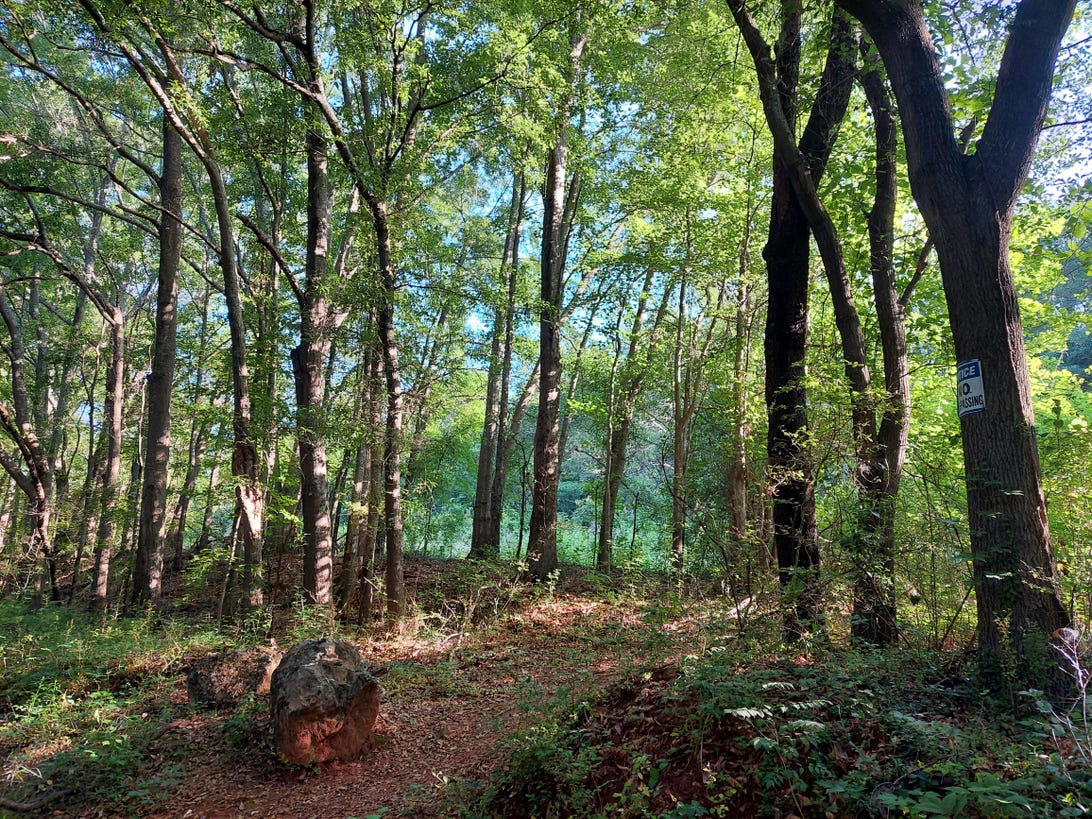
By collecting data on their environment, trees can help tell the bigger story about what's going on on our planet.
Patrick Holland/CNETA spacecraft in low-Earth orbit singing a duet with trees down on Earth sounds like a scene out of a bizarre science fiction film. But if a group of NASA scientists and artists have their way, it'll be a real-life collaboration lasting two centuries.
The teamup of trees and machine, a public art/science project called The Tree of Life, "connects Earth and outer space through a song, which is sent via radio waves between an orbiting spacecraft and an unlikely technological component: a set of live trees that have been activated to operate as large, living antenna systems," reads a description of the inaugural project from the Space Song Foundation. That's a newly formed nonprofit dedicated to designing and fabricating sustainable technology that supports long-range space missions.
Digital sensors will pick up shifts in the trees' environment, and custom software will translate those data points into sonic frequencies that beam to the small, distant spacecraft. In turn, the craft will in turn beam back data about its own operational capacity.
"As the light, water and temperature at the tree change, so does the tune, the volume, and the actual sound of the song," says Julia Christensen, president of the Space Song Foundation, which stands at the intersection of science, art and design.
"In the short term, we hear shifts in the song as day turns to night, as clouds pass over the tree, as seasons change, etc.," adds Christensen, chair of the studio art program at Oberlin College. "But over the very long term -- decades or centuries -- we will hear major global shifts in climate and other changes on our planet."
The Tree of Life began as part of an initiative to design a potential future spacecraft to reach Proxima B, an exoplanet 4.2 light-years away that appears situated to host potential life. Traveling that distance would take an estimated 6,300 years with current technology, which is why scientists are looking at innovations that push the limits of tech longevity. Artists are helping them do that creatively.
Artists involved with the Space Song Foundation could have chosen virtually any object for the terrestrial piece of their experimental communication system. So why trees? Because they (should) continue to exist for many decades and can tell a larger story about life on our planet.
"The Tree of Life takes steps towards demonstrating our long-view approach to design and nature, on Earth and in outer space," says Christensen, whose work explores consumerism and the complexities of e-waste on our planet and in outer space, an increasing concern as space exploration becomes more accessible.
But while trees are ready for the spotlight, the spacecraft at the center of the acoustic experiment has yet to be constructed.
Steve Matousek, advanced concept manager at NASA JPL's Innovation Lab, says the team will start testing prototypes based on cubesats in the next year. By (hopefully) operating continuously for 200 years, the spacecraft would push the constraints of technological obsolescence beyond the limited lifespans of the cell phones, tablets and laptops that populate Earth today.
"The design has no moving parts and the electronics are on only 1% of the time," says Matousek, who has worked on missions from the Voyager to Juno to MarCo. "Imagine if your car, or your computer, or your phone, needed to last 200 years. The simpler the spacecraft the better."
The Space Song Foundation is currently raising money for the Tree of Life on Kickstarter, where the project has pulled in more than $11,500 toward its $15,000 goal, with three days remaining in the campaign. (Keep in mind that not all Kickstarter projects deliver on time or as promised.)
If all goes according to plan, the first two trees will start "singing" in public spaces in New York and Los Angeles, with speakers broadcasting the duet in real time. Funds raised on Kickstarter will go toward the equipment needed to wire up the two trees.
So what, exactly, does it sound like when a spacecraft and trees share the mic? Don't expect anything like David Bowie's Space Oddity or the Beatles' Across the Universe. Sample audio for the project sounds more like the steady screech you hear during tests of the emergency broadcast system.
That's just the baseline track, though. The song will be open source. Musicians can add to it, DJs can re-mix it, and scientists can use it to detect shifts in data sets. It will belong to all of us.
Read Again https://www.cnet.com/news/nasa-scientists-hope-singing-trees-could-help-us-reach-another-planet/Bagikan Berita Ini















0 Response to "NASA scientists hope singing trees could help us reach another planet - CNET"
Post a Comment